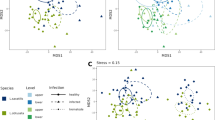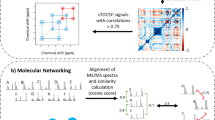Abstract
A mass mortality often occurs from molting to the megalopa stage during the larval development of the swimming crab Portunus trituberculatus. Larvae with insufficient nutrient accumulation during the zoeal stages are probably unable to develop into juvenile swimming crabs. However, the nutritional information such as the primary metabolites is scarce for P. trituberculatus larvae. The aim of this work is to obtain an insight into the metabolite traits of P. trituberculatus at early developmental stages. 1 H nuclear magnetic resonance spectroscopy coupled with multivariate data analysis was used to determine how the metabolite profiles shift during larval development in P. trituberculatus. Our results show that the trend of total metabolites exhibited a rise from zoea 1 to zoea 3, followed by a drop from zoea 4 to megalopa and recovery during the first juvenile stage. A large-scale depletion of total metabolites in the zoea 4 and megalopa stages suggests a deep depression of metabolic activity, which may be linked to the mass mortality from molting to the megalopa stage. These findings provided essential metabolic information about the larval development of P. trituberculatus and important clues for understanding the nutritional requirements of P. trituberculatus in early developmental stages.
Similar content being viewed by others
References
Andrés M, Estévez A, Hontoria F, Rotllant G. 2010. Differential utilization of biochemical components during larval development of the spider crab Maja brachydactyla (Decapoda: Majidae). Mar ine Biology, 157 (10): 2 329–2 340.
Anger K. 1998. Patterns of growth and chemical composition in decapod crustacean larvae. Invertebr ate Reprod uction & Dev elopment, 33 (2–3): 159–176.
Anger K. 2001. The Biology of Decapod Crustacean Larvae. A.A. Balkem, Lisse.
Aue W P, Bartholdi E, Ernst R R. 1976a. Two–dimensional spectroscopy. Application to nuclear magnetic resonance. The Journal of Chem ical Phys ics, 64 (5): 2 229–2 246.
Aue W P, Karhan J, Ernst R R. 1976b. Homonuclear broad band decoupling and two–dimensional J–resolved NMRspectroscopy. The Journal of Chem ical Phys ics, 64 (10): 4 226–4 227.
Augusto A, Greene L J, Laure H J, McNamara J C. 2007. Adaptive shifts in osmoregulatory strategy and the invasion of freshwater by brachyuran crabs: evidence from Dilocarcinus pagei (trichodactylidae). Journal of Exp erimental Zoology, 307 A(12): 688–698.
Avella M, Ducoudret O, Pisani D F, Poujeol P. 2009. Swellingactivated transport of taurine in cultured gill cells of sea bass: physiological adaptation and pavement cell plasticity. Am erican Journal of Physiology Regul atory, Integr ative and Comp arative Physiology, 296 (4): R1 149–R1 160.
Boisen S. 2003. Ideal dietary amino acid profiles for pigs. In: D’Mello J P F ed. Amino Acids in Animal Nutrition. CABI, Edinburgh, United Kingdom. p.103–123.
Braunschweiler L, Ernst R R. 1983. Coherence transfer by isotropic mixing: application to proton correlation spectroscopy. Journal of Magn etic Reson ance (1969), 53 (3): 521–528.
Brucet S, Boix D, López–Flores R, Badosa A, Quintana X D. 2005. Ontogenic changes of amino acid composition in planktonic crustacean species. Mar ine Biology, 148 (1): 131–139.
Chen S L, Wu X G, Cheng Y X, Wang C L, Zhu D F, Zhou B, Wang J F, Gong L J. 2007. Changes of proximate biochemical composition and energy source during embryonic development of swimming crab, Portunus trituberculatus. Journal of Fish ery Sciences of Chin a, 14 (2): 229–235. (in Chinese with English abstract)
Cloarec O, Dumas M E, Trygg J, Craig A, Barton R H, Lindon J C, Nicholson J K, Holmes E. 2005. Evaluation of the orthogonal projection on latent structure model limitations caused by chemical shift variability and improved visualization of biomarker changes in 1 H NMR spectroscopic metabonomic studies. Anal ytical Chem istry, 77 (2): 517–526.
Committee on the Nutrient Requirements of Fish and Shrimp, Board on Agriculture and Natural Resources, National Research Council. 2011. Nutrient Requirements of Fish and Shrimp. National Academies Press, Washington, DC. p.57–92.
Conlan J A, Jones P L, Turchini G M, Hall M R, Francis D S. 2014. Changes in the nutritional composition of captive early–mid stage Panulirus ornatus phyllosoma over ecdysis and larval development. Aquaculture, 434: 159–170.
Dan S, Kaneko T, Takeshima S, Ashidate M, Hamasaki K. 2013. Variations in larval morphology and their relationships to survival during mass seed production by the swimming crab, Portunus trituberculatus (Brachyura, Portunidae). Aquaculture, 414–415: 109–118.
Eriksson L, Trygg J, Wold S. 2008. CV–ANOVA for significance testing of PLS and OPLS ® models. Journal Chemometr ics, 22 (11–12): 594–600.
Fan T W M. 1996. Metabolite profiling by one–and twodimensional NMR analysis of complex mixtures. Progress in Nuclear Magnetic Resonance Spectroscopy, 28 (2): 161–219.
Hammer K M, Pedersen S A, Størseth T R. 2012. Elevated seawater levels of CO 2 change the metabolic fingerprint of tissues and hemolymph from the green shore crab Carcinus maenas. Comp arative Biochem istry and Physiology Part D: Genomics and Proteomics, 7 (3): 292–302.
Hao G J, Lin F, Mu C K, Li R H, Yao J Y, Yuan X M, Pan X Y, Shen J Y, Wang C L. 2015. SNP E4–20. C/T in C–type lectin of Portunus trituberculatus is association with susceptibility/resistance to Vibrio alginolyticus challenge. Aquaculture, 442: 125–131.
Haond C, Bonnal L, Sandeaux R, Charmantier G, Trilles J P. 1999. Ontogeny of intracellular isosmotic regulation in the European lobster Homarus gammarus (L.). Physiological and Biochem ical Zoology, 72 (5): 534–544.
Hird F J R. 1986. The importance of arginine in evolution. Comp arative Biochem istry and Physiology Part B: Comparative Biochemistry, 85 (2): 285–288.
Holme M H, Zeng C S, Southgate P C. 2009. A review of recent progress toward development of a formulated microbound diet for mud crab, Scylla serrata, larvae and their nutritional requirements. Aquaculture, 286 (3–4): 164–175.
Hu S, Wang J, Han T, Li X, Jiang Y, Wang C. 2016. Effects of dietary DHA/EPA ratios on growth performance, survival and fatty acid composition of juvenile swimming crab ( Portunus trituberculatus ). Aquaculture Research, 48 (3): 1 291–1 301.
Ikeda T, Smith G, McKinnon A D, Hall M. 2011. Metabolism and chemical composition of phyllosoma larvae, with special reference to the tropical rock lobster Panulirus ornatus (Decapoda; Palinuridae). Journal of Experimental Marine Biology and Ecology, 405 (1–2): 80–86.
Jin M, Wang M Q, Huo Y W, Huang W W, Mai K S, Zhou Q C. 2015. Dietary lysine requirement of juvenile swimming crab, Portunus trituberculatus. Aquaculture, 448: 1–7.
Jin M, Zhou Q C, Wang M Q, Huo Y W, Huang W W, Mai K S. 2016. Dietary arginine requirement of juvenile swimming crab, Portunus trituberculatus. Aquaculture Nutr ition, 22 (6): 1 174–1 184.
Kean J C, Castell J D, Boghen A G, D’Abramo L R, Conklin D E. 1985. A re–evaluation of the lecitihin and cholesterolrequirements of juvenile lobster ( Homarus americanus ) using crab protein–based diets. Aquaculture, 47 (2–3): 143–149.
Lim B K, Hirayama K. 1991. Growth and elemental composition (C,N,P) during larval developmental stages of mass–cultured swimming crab Portunus trituberculatus. Marine Ecology Progress Series, 78: 131–137.
Mazzarelli C C M, Santos M R, Amorim R V, Augusto A. 2015. Effect of salinity on the metabolism and osmoregulation of selected ontogenetic stages of an amazon population of Macrobrachium amazonicum shrimp (Decapoda, Palaemonidae). Braz ilian Journal of Biology, 75 (2): 372–379.
Millamena O M, Quinitio E. 2000. The effects of diets on reproductive performance of eyestalk ablated and intact mud crab Scylla serrata. Aquaculture, 181 (1–2): 81–90.
Minagawa M, Chiu J R, Murano M. 1993. Developmental changes in body weight and elemental composition of laboratory–reared larvae of the red frog crab, Ranina ranina (Decapoda: Brachyura). Marine Biology, 116 (3): 399–406.
Morioka Y, Kitajima C, Hayashida G. 1988. Oxygen consumption, growth and calculated food requirement of the swimming crab Protunus trituberculatus in its early developmental stage. Nippon Suisan Gakkaishi, 54 (7): 1 137–1 141.
Peñaflorida V D. 2004. Amino acid profiles in the midgut, ovary, developing eggs and zoea of the mud crab, Scylla serrata. Isr aeli Journal of Aquacult ure–Bamidgeh, 56 (2): 111–123.
Ponat A, Adelung D. 1983. Studies to establish an optimal diet for Carcinus maenas: 3. Vitamin and quantitative lipid requirements. Mar ine Biology, 74 (3): 275–279.
Preston R L. 1993. Transport of amino acids by marine invertebrates. Journal of Experimental Zoology, 265 (4): 410–421.
Sheen S S, Wu S W. 1999. The effects of dietary lipid levels on the growth response of juvenile mud crab Scylla serrata. Aquaculture, 175 (1–2): 143–153.
Sheen S S. 2000. Dietary cholesterolrequirement of juvenile mud crab Scylla serrata. Aquacult ure, 189 (3–4): 277–285.
Sun Y M, Yan Y, Sun J J. 1984. The larval development of Portunus trituberculatus. Journal of Fish eries of Chin a, 8 (3): 219–226. (in Chinese with English abstract)
Suprayudi M A, Takeuchi T, Hamasaki K. 2004. Essential fatty acids for larval mud crab Scylla serrata: implications of lack of the ability to bioconvert C18 unsaturated fatty acids to highly unsaturated fatty acids. Aquacult ure, 231 (1–4): 403–416.
Trygg J, Holmes E, Lundstedt T. 2007. Chemometrics in metabonomics. Journal of Proteome Res earch, 6 (2): 469–479.
Trygg J, Wold S. 2002. Orthogonal projections to latent structures (O–PLS). Journal of Chemometr ics, 16 (3): 119–128.
Upmeier B, Gross W, Köster S, Barz W. 1988. Purification and properties of S–adenosyl–L–methionine:Nicotinic acid–N–methyltransferase from cell suspension cultures of Glycine max L. Arch ives of Biochem istry and Biophys ics, 262 (2): 445–454.
Van Den Berg R A, Hoefsloot H C J, Westerhuis J A, Smilde A K, Van Der Werf M J. 2006. Centering, scaling, and transformations: improving the biological information content of metabolomics data. BMC Genomics, 7: 142.
Wu X G, Zeng C S, Southgate P C. 2014. Ontogenetic patterns of growth and lipid composition changes of blue swimmer crab larvae: insights into larval biology and lipid nutrition. Mar ine and Freshwater Res earch, 65 (3): 228–243.
Xiao C N, Hao F H, Qin X R, Wang Y L, Tang H R. 2009. An optimized buffer system for NMR–based urinary metabonomics with effective pH control, chemical shift consistency and dilution minimization. Analyst, 134 (5): 916–925.
Xie Z M, Liu H J, Feng L. 2002. Breeding of swimming crab, Portunus trituberculatus. In: Xie Z M ed. Hatchery Technology of Marine Economic Crabs. China Agriculture Press, Beijing, China. p.1–304. (in Chinese)
Yancey P H, Blake W R, Conley J. 2002. Unusual organic osmolytes in deep–sea animals: adaptations to hydrostatic pressure and other perturbants. Comp arative Biochem istry and Physiology Part A: Molecular & Integr ative Physiology, 133 (3): 667–676.
Yancey P H. 2005. Organic osmolytes as compatible, metabolic and counteracting cytoprotectants in high osmolarity and other stresses. Journal of Exp erimental Biology, 208 (15): 2 819–2 830.
Ye Y F, An Y P, Li R H, Mu C K, Wang C L. 2014. Strategy of metabolic phenotype modulation in Portunus trituberculatus exposed to low salinity. Journal of Agric ultural and Food Chem istry, 62 (15): 3 496–3 503.
Author information
Authors and Affiliations
Corresponding authors
Additional information
Supported by the National Natural Science Foundation of China (No. 41673076), the Major Agriculture Program of Ningbo (No. 2017C110007), China Agriculture Research System-CARS48, and the K. C. Wong Magna Fund in Ningbo University
Electronic supplementary material
Rights and permissions
About this article
Cite this article
Shi, C., Zeng, T., Li, R. et al. Dynamic metabolite alterations of Portunus trituberculatus during larval development. J. Ocean. Limnol. 37, 361–372 (2019). https://doi.org/10.1007/s00343-019-7268-0
Received:
Accepted:
Published:
Issue Date:
DOI: https://doi.org/10.1007/s00343-019-7268-0




